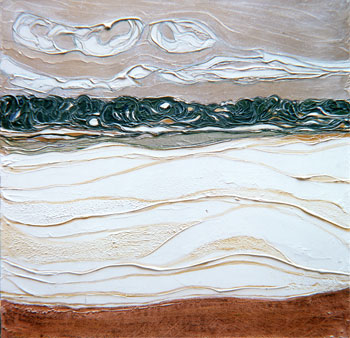Franco Solmi
Franco Solmi, 1987
 Brazilian landscape, 1999 - Mixed technique on canvas - cm 80x80 - Governor Roseane Sarney Collection - Maran
Brazilian landscape, 1999 - Mixed technique on canvas - cm 80x80 - Governor Roseane Sarney Collection - Maran
Giuseppe Borrello is as certainly atypical artist as the Neapolitan painters that have had also discount in these last decades a situation atypical, not referable to the lines teachers of the artistic culture of our country if not for vague references a great deal. I won't be the first one to notice that to the aggression of the codes and the formal models of language, typical of the international style, Naples has reacted in unpredictable way. Nearby to a rapid updating of surface and to implacable processes of expressive homologation he has come in fact creating intense forms of resistance, due for more to a pertinace also defended of the individuality and what as it regards other sectors we could define one “specific” of the high civilization of this earth. Borrello is as cultured and informed artist on the international stories others but, as it happens to whom cultivates for vocation or for damnation an image that cannot put aside from the existential conditionings, he proceeds more for deviances and transgressions that not for fidelity to the norms of the current imagerie, aesthetics or no that it declares. This makes at the same time useful and inopportune and respect every quotation. Seem indeed therefore very acute Francesco's Butturini observation that, after having revealed all the possible names of teachers whose trace finds again him in the works of Borrello - from Matisse to Klee and Kandisky, up to Kirchner, Soutine, Ensor, De Chirico and Aligi Sassu - he affirms: “If a teacher there is in the history of Giuseppe Borrello he is Emilio Notte and how much he represented in the Neapolitan school of the fifties.”
Well, what Emilio Notte taught with his life of incurable and uneven art close was just the freedom to earn it through a contentious solitude but concretely fight and confront everything that affects the being of man and artist. It seems to me so with the fact that it is not subtracted Borrello, he so hopelessly “Mediterranean”, the charm of Nordic concerns at that contrast unbearable horror and beauty, for example, that shines in gold unfortunate of Klimt. It is, in short, a restless character that the artist today can rediscover within and outside dimensions of myth.
For it maintains the solarity of the colors and the line lives, also dragged in mysterious vortexes, it maintains one classical firmness. The work always appears us clear, both when the graphic torment seems to upset its inside rhythms both whereas the image finds one his metaphysical pacification, a sort of spellbound amazement, fruit of a conquered formal equilibrium more than of a satisfied conscience of the things. In effects Borrello is an artist of deep restlessness that, at times have conducted him to cross the limits of the formal rigor, to give symbolic accentuations and metaphoric redundances to his own compositions, especially whereas the wave of the sign instead of flowing free and singer got chocked up in the tangles of a figuration and a story of the memory stopped in his descriptive moment. The true nature of Borrello reveals in works of extraordinary formal transparency and as many extraordinary complexity as it is above, the stars, that hold symbolic painting of a rilettura in key of new metaphysics of the ancient and modern solarity of the art. The painter, when he succeeds in loosening in rhythm the blocks of a subject sign that he feels as paraphrase of the subject and the existential signs, he draws the vertexes of his anxious metaphysics and that suspension in which the decorative (Curtain) image more highly sublimes also him or more organically pulsating and crowded (Sacred magic enclosure). It is something than very similar to what it happens in the relationships among the colors, used by abstracting in operation Borrello in the same moment in which he builds images of strange fixity with them or, as it has well written Mario Cattafesta in a 1983 text, “visions of impact neoplatonist, of concrete evanescence.”
Whoever can verify how much this dialectical trial between reality and dream, between memory of the present and premonition of a possible old-fashioned image that assumes weight and concreteness in the work of Borrello, artist of petrified but throbbing tensions in the apprehension of the myth.




